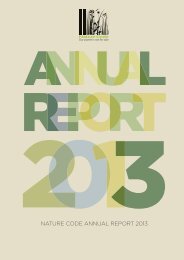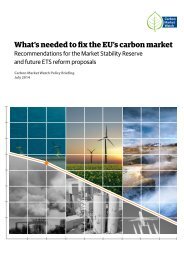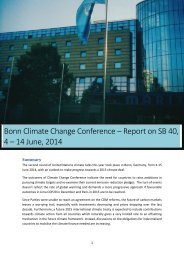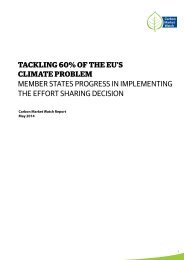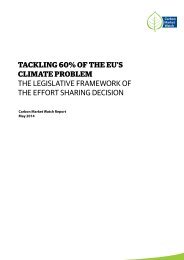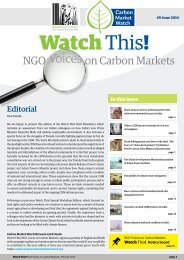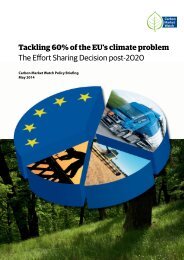Analysis of Europe’s 2030 Climate Ambition
You also want an ePaper? Increase the reach of your titles
YUMPU automatically turns print PDFs into web optimized ePapers that Google loves.
Currently, the CO 2 emissions and removals from agriculture and land use, land use change and forestry<br />
(LULUCF) are excluded from EU’s 2020 climate target. However, in order to tackle climate change all<br />
sectors should contribute to the mitigation efforts in the future, including the climate impact <strong>of</strong> the<br />
agriculture and the LULUCF sector. The Heads <strong>of</strong> State have invited the Commission to look into the best<br />
ways <strong>of</strong> ensuring that also the LULUCF sector contributes to greenhouse gas mitigation and increased<br />
sequestration.<br />
The results <strong>of</strong> a recent Commission’s impact assessment has shown that a separate framework for<br />
LULUCF is the preferred option to tackle the sector’s climate impact and to ensure the integrity <strong>of</strong> the<br />
EU’s climate framework. Because the LULUCF sector is fundamentally different from the sectors<br />
currently subject to EU’s climate legislation, due to its inherent characteristics such as non-permanence,<br />
data uncertainties and inter-annual variability, it seems unfit for inclusion in the current climate laws.<br />
Previous drafts <strong>of</strong> the council conclusions also indicated that certain countries should be allowed to<br />
<strong>of</strong>fset agriculture emissions with afforestation projects. This option appeared to have been included at<br />
the request <strong>of</strong> Ireland, which has a large agriculture sector. The final council conclusions however only<br />
include a very implicit reference when mentioning in one sentence both intensification <strong>of</strong> food<br />
production and optimized sequestration “including through afforestation”.<br />
Next steps<br />
- The European Commission is expected to come forward with new legislation how to tackle the<br />
climate impact <strong>of</strong> the LULUCF sector before 2020.<br />
Carbon Market Watch Recommendations<br />
- The LULUCF sector is best placed in a separate pillar, since the sector’s characteristics (annual<br />
fluctuations, long-time horizons, uncertain data reliability) make the sector unfit for inclusion in<br />
the legislation covering the non-ETS emissions that requires annual compliance.<br />
- Tackling the climate impact <strong>of</strong> the LULUCF sector should be additional to the mitigation efforts<br />
in other sectors and can thereby enhance the ambition <strong>of</strong> the overall EU climate framework.<br />
- The sink function <strong>of</strong> the LLULUCF sector should not be used to displace mitigation efforts in the<br />
buildings, transport and agriculture sectors.<br />
Nine NGOs, including Carbon Market Watch, have recently published best practice principles for how<br />
best to deal with LULUCF in the EU’s climate framework, see here .<br />
6. Financial support to the power sector in low-income states<br />
The <strong>2030</strong> council conclusions read:<br />
2.5 in this context, Member States with a GDP per capita below 60% <strong>of</strong> the EU average may opt to<br />
continue to give free allowances to the energy sector up to <strong>2030</strong>. The maximum amount handed out<br />
for free after 2020 should be no more than 40% <strong>of</strong> the allowances allocated under 2.9 for auctioning<br />
to the Member States using this option. The current modalities, including transparency, should be<br />
improved to ensure that the funds are used to promote real investments modernising the energy<br />
sector, while avoiding distortions <strong>of</strong> the internal energy market;<br />
2.7 a new reserve <strong>of</strong> 2% <strong>of</strong> the EU ETS allowances will be set aside to address particularly high<br />
additional investment needs in low income Member States (GDP per capita below 60% <strong>of</strong> the EU<br />
average). It will have the following characteristics:<br />
- the proceeds from the reserve will be used to improve energy efficiency and to modernise the energy<br />
systems <strong>of</strong> these Member States, so as to provide their citizens with cleaner, secure and affordable<br />
energy;<br />
11







